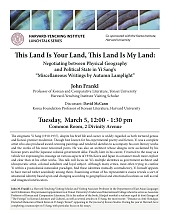Date:
Location:
Harvard-Yenching Institute Lecture

John Frankl
Associate Professor of Korean and Comparative Literature, Yonsei University; Visiting Scholar, Harvard-Yenching Institute
Chaired by David R. McCann, Korea Foundation Professor of Korean Literature, Harvard University
Abstract
The enigmatic Yi Sang (1910-1937), despite his brief life and career, is widely regarded as both tortured genius and Korea’s premier modernist. Though best known for his experimental poetry and fiction, Yi was a complete artist who also produced award-winning paintings and rendered sketches to accompany his own literary works and the works of his most renowned peers. He was also an architect whose designs were acclaimed by his Korean peers and the Japanese colonial government alike. Finally, later in his career, Yi turned to the essay as a vehicle for expressing his musings on various aspects of 1930s Korea and Japan in a manner much more explicit and clear than in his other works.
This paper will focus on Yi’s multiple identities as government architect and idiosyncratic artist, colonial subaltern and loyal subject. Although many critics, most often trying to confine Yi within a postcolonial nationalist paradigm, find these identities mutually contradictory, Yi himself appears to have moved rather seamlessly among them. Examining certain of his representative essays reveals a sort of situational identity based upon and changing according to geographical and emotional locations as well as real and imagined interlocutors. In particular, his essay “Miscellaneous Writings by Autumn Lamplight,” written in October 1936, the same month he would venture for the first time to Tokyo, where he would meet his untimely end only a few months later, Yi surefootedly negotiates a rugged terrain of competing identities as a modernist writer, an ethnic Korean, and a subject of Imperial Japan. Interrogating his various stances provides small but important glimpses into modernism’s movement from Europe to Asia, its adoption and modification in Japan and Korea, as well as how it informed the sensibilities of colonized artists who worked under the disquieting condition of artistic freedom coupled with political repression.
Co-sponsored by the Korea Institute